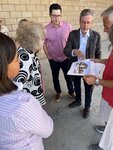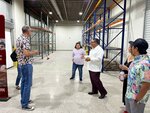Wind: 17.3 mph, W
Welcome to our new web site!
To give our readers a chance to experience all that our new website has to offer, we have made all content freely avaiable, through October 1, 2018.
During this time, print and digital subscribers will not need to log in to view our stories or e-editions.





As he was driving past Casa de Peregrinos (CdP) emergency food program’s new building on Amador Avenue one evening recently, Executive Director Lorenzo Alba stopped to admire progress. The outdoor lights were on, and it was “starting to look like it should look,” he said.
“I just felt at that moment, ‘I’ve had a total encounter with God,’” Alba said. “I’m not going to take this for granted.”
Despite COVID, supply-chain issues and increased costs, construction on the state-of-the-art building was completed in early August “by the grace of God,” and because “people said yes to this project,” Alba said, including the Las Cruces City Council and city administration, the builder, other nonprofits, CdP clients, CdP staff (there are 16), the nonprofit’s board of directors (there are 19) and volunteers.
The new building, 999 W. Amador Ave., is directly in front of the old building, and includes a new roadway connecting Amador Avenue with the Mesilla Valley Community of Hope (MVCH) campus.
Funding for the new building includes $168,458 in state capital projects funds, $3.83 million in state legislative appropriations and $3.75 million from the city of Las Cruces Telshor Fund.
Most of the CdP’s 200 or so regular volunteers live in the Las Cruces area, but occasionally people driving through town will stop at CdP to volunteer for a few hours, he said.
The impact of even a single day of volunteering at CdP “makes an incredible impact” on the lives of the people the program serves, Alba said.
The 13,000-square-foot headquarters for CdP programs that reach throughout Doña Ana County, “will really impact food insecurity,” he said.
It includes a walk-in freezer that is 10 times the size of the one in the old CdP location, Alba said, and a walk-in refrigerator that is 14 times bigger than the old one. There’s a clean room for processing food and a large distribution area that opens onto the drive-up lane that will initially serve 12 vehicles in 45 minutes and then expand to 16, Alba said.
The goal is to eventually serve 65-70 percent of CdP clients via the drive-up, he said.
The new lobby – including the George W. Miller Community Wall honoring a long-time CdP and MVCH board member and volunteer and the mural by Francisco Romero – is three times bigger than the old lobby. It connects directly to CdP’s new commercial kitchen and can be used for cooking demonstrations – CdP has added a nutritionist to its board – and even converted into a classroom. There are cameras in the kitchen so trainings and demonstrations can be presented live online or on video.
The lobby also has a skylight.
“We made it really beautiful,” Alba said.
The new building has offices that other agencies can use to hold office hours, he said. Furniture was donated by WestStar Bank.
There’s a boardroom that can be used as a training room, Alba said, and there are men’s and women’s restrooms to replace the single bathroom in the old building. There is also a break room and outdoor patio for staff and volunteers.
The new building will also include a food pharmacy, Alba said, with providers catering to the special dietary needs of people with cancer, diabetes and other health issues.
There’s a much larger and more easily accessible loading dock and even a cardboard bailer to process the large number of boxes CdP collects so they can be recycled or resold. And, there are outdoor cameras for security and staff and visitor safety.
“We built this for the community,” Alba said, pointing out that the front of the building “looks like a grocery store. That was intentional,” he said. “We wanted to make sure it looked inviting.”
CdP provides 4.5-five million pounds of food to clients throughout the county each year.
With the new headquarters, “We can get better at it,” Alba said. “We can provide better service and more options for our hungry clients.”
And Alba is not done yet. He has $1.9 million in capital outlay funds to pay for CdP’s expansion phase 2, which will include a new soup kitchen and demonstration kitchen behind the new CdP building.
“I will be very aggressive this fall,” Alba said, as he seeks an additional $11-$12 million to complete the second phase.
According to its 2022-23 annual report, CdP served 39,463 clients in 2022, served/distributed 3.5 million meals and distributed 4.2 million pounds of food.
Visit www.casadeperegrinos.org.